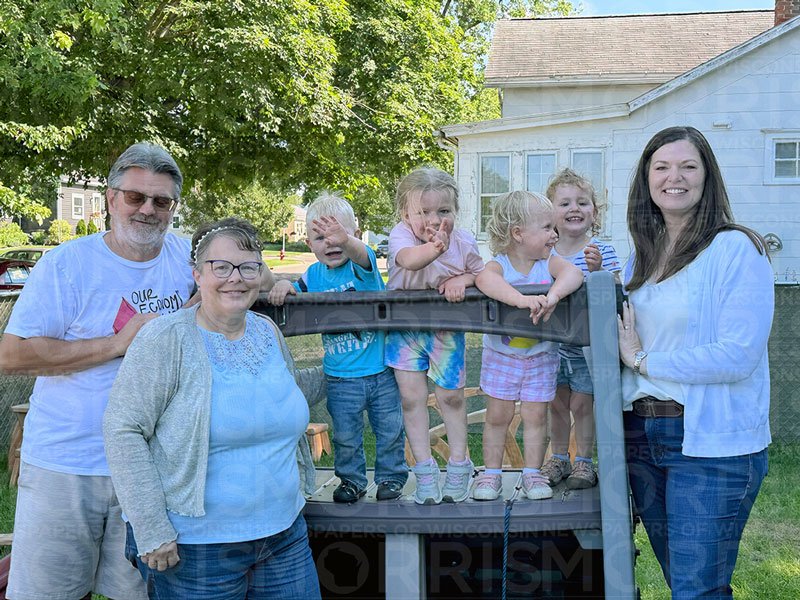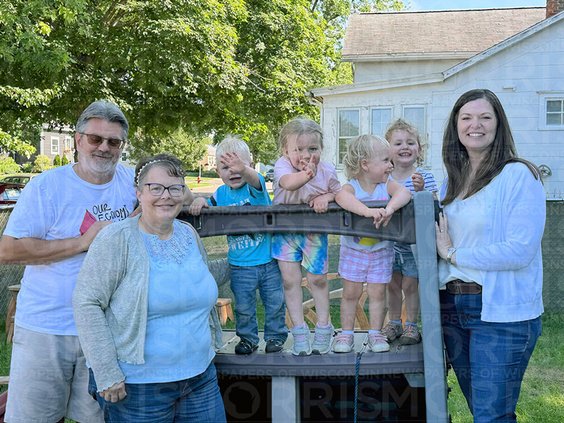MONROE — For years — especially over the past five years — child care advocates have been blowing the whistle to alert the masses of a major funding shortfall — one which could be a major strain to the local economy. While others have heard the whistles for help — mostly parents of young children and education-based workers — the ones who can make a difference, namely politicians in the state legislature, have kept their ears plugged.
Visited by Sen. Howard Marklein (17th District-Spring Green) in August 2023, child care provider Christina Becker said that while the meeting went well overall, “I’m afraid everything went in one ear and out of the other.”
On July 18, Rep. Jenna Jacobson (50th District-Oregon), an announced challenger to Marklein’s seat, visited the same home to hear what the providers and parents of the children they care for had to say.
Christina’s Family Daycare, owned and operated by Christina Becker and husband Tom, had a different feeling to their guest this time around.
“I appreciate that you listen with your heart,” Christina, a child care provider for more than 30 years, told Jacobson.
“This time, it did not go in one ear and out the other,” Tom said afterwards.
In the most recent bipartisan 2025-27 state budget passed earlier this month, the money allowed for Child Care Counts Stabilization, a federal COVID-19 relief program that has provided the state with $480 million, comes up well short of desired expectations and is not a long term fix. In order to make up the rising costs, most providers will either have to raise their rates, cut their wages, or a mix of both.
The Beckers are one of just five in-home day care providers in Monroe, and two appear to be set to close over the next year — one due to their own child joining full-time public schooling, and the other retiring.
New Glarus isn’t faring much better, as a child care provider there, Corrine’s Little Explorers, is closing, too. However, the children she was providing care for all found a new location, making the change relatively smooth. That won’t always be the case, though.
Green County has seen a decline of child care programs by 40% over a little more than the past decade, from 52 in 2014 to just 31 this year. In Lafayette County, the rate is down by more than 51%. In fact, 71 of 72 Wisconsin counties saw a decrease over the past decade, with only Milwaukee County not seeing a decrease, according Wisconsin Early Childhood Association (WECA).
A recently released UW-Madison Institute for Research on Poverty study surveyed about 80% of Wisconsin’s regulated child care providers. Anticipating the ending of the Child Care Counts Stabilization program, which Green County programs receive $4.3 million for, a record number of providers will likely close, spiking tuition rates for families as open slots would overwhelmingly shrink.
The study shows that, in Green County alone, the ending of Child Care Counts would mean:
● 54% of child care programs closing
● 44% reduction in the total number of in children served
● 35% weekly tuition increase for families
● 30% of programs would likely reduce their available hours of care
Green County has approximately 2,300 children under the age of 5, with about 1,700 needing care — approximately 74%. The current capacity for regulated care is just 1,204 — nearly 500 slots short.
“We’ve got to fix this,”Jacobson said. “I don’t know what the plan is, but I have to say thank you to you all for your advocacy, because without that, we wouldn’t have gotten to where we are. “This is a huge conversation in our state, and it wasn’t for so long.”


The Vermont Plan is gaining interest
One of the suggestions for a possible way out is the “Vermont Plan,” the Becker’s told Jacobson.
Corrine Hendrickson, owner of Corrine’s Little Explorers, child care advocate and a potential candidate for Marklein’s seat as well, presented other providers with information on how Vermont (pop. about 650,000) is handling their situation.
“I have spoken with several people from Vermont 1-on-1 about this program throughout the last few years,” Hendrickson wrote in an email to the Beckers. “Based off employer tax records from 2024, this would bring in about 1.6 billion in revenue over 2 years. This does NOT include any increase in revenue that would likely happen due to increased wages of 8-10 an hour for the teachers, more parents able to work, less missed work, etc.”
Using an employer payroll tax, the amount received per child in Vermont is about double what Wisconsin providers are getting, which is why providers in the New England state “are able to raise wages and increase recruitment and retention while simultaneously stabilizing and/or lowering costs to parents,” Hendrickson explains. Passed in 2023 as Act 76, the payroll tax, enacted on July 1 last year, has added about 1,000 slots and about 100 programs in Vermont — and mainly in rural areas.
Among the key partners in Vermont is Main Street Alliance, which works to get small business and employers support. Wisconsin has its own Main Street Alliance chapter working on the cause right now.
In Vermont, employers and self-employed individuals are required to pay the Vermont Child Care Contribution tax, according to Chris Nelson, a Vermont child care provider. Employers pay a 0.44% payroll tax on wages paid, with an option to withhold up to 25% of the tax from employees. Self-employed individuals will pay a 0.11% tax on self-employment income.
“Many businesses that I have spoken to actually don’t charge the employees because they can call it a benefit and the payroll department would cost more if they processed then the .11 percent that they can charge the employees,” Nelson said. “If a business opts to split the cost, then the business pays .33 percent, and the employee pays the remaining .11 percent. I have not heard any businesses complaining about this Child Care Contribution since it has been enacted, large or small businesses. Most complaints were from employees who had a hard time understanding the (decimal point) and assumed that it was an 11 percent tax.”
Nelson added that all Vermont employees (businesses) pay this Contribution tax. Because it is a payroll contribution only, those receiving SSI, ANFC and retired workers do not have their fixed incomes strained — only working people contribute.
“We are a small state. This amount is a small amount per individual but the benefits to the childcare field are enormous” Nelson said.
In Vermont, the payroll tax is administered at the county level, though Hendrickson doesn’t believe that would work out as well here in Wisconsin, she told the Beckers. “Using the system created for child care counts would be a better, more efficient, and allow more of the funding to go to the wages of the educators instead,” Hendrickson said.
Wisconsin’s population of about 5.9 million is more than eight times larger than Vermont’s.
Child care costs in Wisconsin rose about 14% just from 2022 to 2023. Approximately 86% of Wisconsin counties have child care costs that push families into the red each month, according to WECA, based in Fitchburg. The Wisconsin Shares Child Care Subsidy Program has an eligibility cap of $5,200 per month for a family of four.


